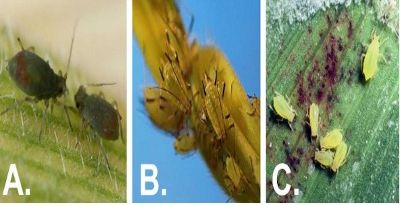
Figure 1. (A) Bird cherry oat aphids. Courtesy: Adam Sisson, Iowa State University, Bugwood.org. (B) English grain aphid. Courtesy: Adam Varenhorst. (C) Greenbug.
Scouting Wheat for Aphids
The easiest way to scout for wheat aphid populations is to start at one side of the field and walk in a “W” of zig-zag pattern. While walking the pattern, randomly choose twenty plants from each leg and examine for aphids. During the spring, the aphids are most commonly observed on the leaves and stems of the plants. Table 1 contains the economic thresholds for the three aphid species. If populations exceed the thresholds, please refer the most-current edition of the South Dakota Pest management Guide: Wheat for insecticides labeled for these pests. The forecasted temperatures for the next week will be favorable for aphid development in wheat.
TABLE 1. ECONOMIC THRESHOLDS FOR APHID PESTS OF WHEAT.
| Number of Aphids Per Plant |
|---|
| Pest | Seedling
Stage | Boot to
Heading Stage | Flowering
Stage | Milky
Ripe Stage | Milk to Medium
Dough Stage |
| Bird cherry oat aphid | 20 | 30 | >5 | 10 | >10 |
| English grain aphid | 30 | 50 | 5 | 10 | >10 |
| Greenbug | 5-15 | 25 | >25 | >25 | >25 |
Source : sdstate.edu